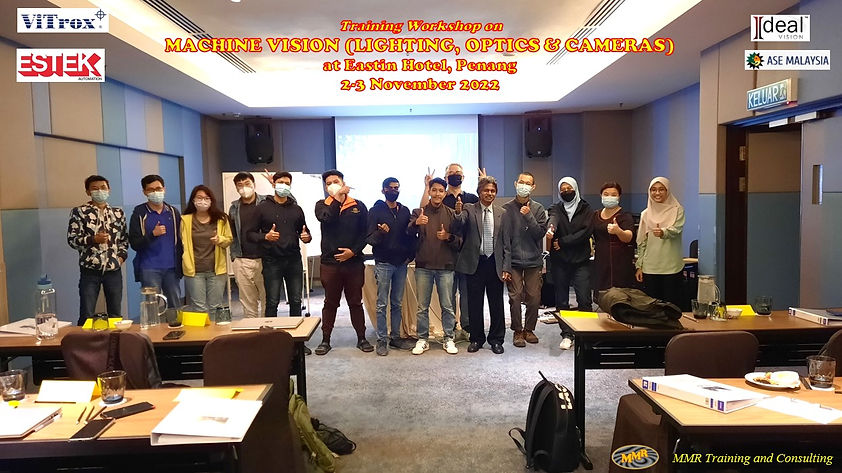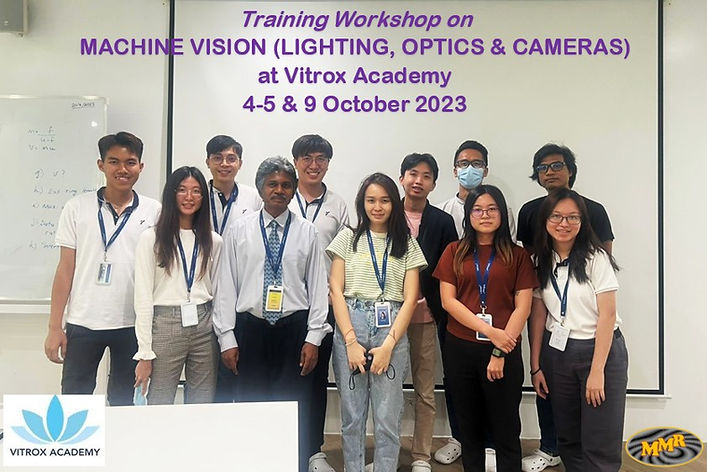
Training Workshop on
MACHINE VISION (LIGHTING, OPTICS & CAMERAS)
(HRD Corp claimable - SBL Khas 10001223963)
[Total number of engineers trained to date: 81]

(In-house training is available. Please contact trainer for quotation)
"The course taught me about a lot of confusion I had in my mind and solved it" - feedback form previous participant
(scroll down to see more comments)

Synopsis
Machine vision systems are crucial part of automation in almost all sectors, such as manufacturing, agriculture, navigation, food industry etc. The application of suitable constraints and selection of proper hardware is necessary to build a low-cost and effective solution to many inspection, measurement, sorting and identification problems in the industry.
This training workshop focuses on the three most fundamental aspects in the design of all machine vision systems, namely lighting, optics and cameras. Participants will learn how to exploit existing constraints and impose new ones in order to simplify the subsequent image processing algorithms, particularly segmentation and feature extraction. They will also learn the various types of application-specific lighting methods, lens selection, and camera selection through activities and case studies of real-life problems, such as detection of bent lead in a leadframe, inspection of print on packaging, inspection of fast-moving bearing on a conveyor etc.
The training workshop is divided into activity-based theory (60%) to strengthen the fundamental knowledge of the participants and hands-on practicals (40%). The practical part will include selection of proper lighting to detect defects in products, tests to determine consistency and uniformity of lighting, selection of lenses to optimize image resolution as well as effect of camera and lens settings on image quality.
How will I benefit?
-
Learn how to simplify machine vision solutions by exploiting and/or imposing constraints
-
Learn the various types of machine vision lighting available in the market
-
Select the correct lighting type to enhance contrast on features of interest
-
Learn how to quantify contrast in an image
-
Determine pulse width required in high-intensity strobe lighting
-
Evaluate consistency and uniformity of machine vision lighting
-
Understand the various camera and imaging parameters, such as FOV, DOF, WD etc.
-
Select suitable camera sensor resolution for specific application
-
Determine maximum exposure to prevent motion blur in image
-
Select suitable lens for optimum magnification and image quality
-
Understand how f-number affects depth-of-field and image quality
-
Determine spatial resolution of an imaging system
-
Determine the data transfer rate in a high-speed application
-
Select suitable camera interface type for a specific application
Course content
Day 1
Part 1 - Scene constraints
-
The generic machine vision model
-
Principal aims of scene constraints
-
Exploited vs. imposed constraints
-
Methods of exploitation of constraints
-
Methods of imposition of constraints
-
Activity 1: Human as the ultimate machine vision system
-
Activity 2: Simplify machine vision solution for diameter measurement
-
Activity 3(a-e): Identify the constraints that can be exploited and/or imposed
-
Activity 4: Suggest improvements to an existing machine vision system
-
Activity 5: Simplify the machine vision problem
Part 2 - Machine vision lighting
-
Aims of machine vision lighting
-
Quantifying contrast in images
-
Diffused front lighting: dome diffuse, on-axis diffuse, flat diffuse, ring diffuse
-
Ring light: High angle, low angle, multi-spectrum diffuse, hybrid brightfield/darkfield
-
Directional lighting
-
Light field vs. dark field back lighting
-
Telecentric lighting for precision measurement
-
Structured lighting for 3-D vision
-
Polarized lighting for glare suppression
-
Strobe lighting for fast-moving object
-
Vision illumination sources vs. spectral content
-
Vision illumination source spectral content vs. camera sensor sensitivity
-
Lighting for multispectral and hyperspectral imaging
-
Methods of overcoming ambient light
-
Factors affecting lighting consistency
-
Assessment of lighting uniformity within FOV
-
Activity 6 (Practical): Improve contrast in image by selecting proper lighting type and geometry
-
Activity 7a: Identify machine vision lighting types
-
Activity 7b: Match lighting type with image
-
Activity 8 (Practical): Investigate effect of lighting type on object features (see activity sheet)
-
Activity 9: Determine pulse width required for strobe light in fast moving object inspection
-
Activity 10: Select lighting using scene characteristics
-
Activity 11a (Practical): Determine consistency of lighting (Download software)
-
Activity 11b (Practical): Determine uniformity of lighting (Download software)
-
Activity 11c (Practical): Determine contrast in an image (Download software)
Day 2
Part 3 - Machine vision optics
-
Common imaging terms - PMAG, FOV, DOF, WD, resolution etc.
-
Lens mount types vs. sensor size
-
Focal length and magnification vs. sensor dimensions
-
f-number and lens numerical aperture vs. depth of focus
-
Resolving power of lens vs. sensor resolution
-
Basics of image formation
-
Telecentric lenses and their uses
-
Lens selection
-
Quiz 1: Determine sensor dimensions using camera specifications (see quiz sheet).
-
Quiz 2: Determine PMAG and lens focal length (see quiz sheet)
-
Quiz 3: Determine maximum magnification and spatial resolution possible (see quiz sheet)
-
Quiz 4: Determine magnification and lens-to-sensor distance (see quiz sheet)
-
Quiz 5: Determine minimum and maximum aperture diameter in a given lens (see quiz sheet)
-
Activity 12: Determine lens to sensor distance, focal length and select commercial lens for typical application (see activity sheet)
-
Activity 13: Increase image resolution using extension tube
-
Activity 14 (Practical): Explore effect of f-number and sensor gain on image quality (see activity sheet)
-
Activity 15 (Group - practical): Capture image of IC chip to fill 90% sensor dimension (see activity sheet)
Part 4 - Machine vision cameras
-
Camera selection process
-
CCD vs. CMOS sensors
-
Interlaced vs. progressive scan
-
Sampling vs. quantization
-
Bit depth and storage space
-
Rolling vs. global shutter
-
Frame rate, shutter speed and exposure time
-
Line vs. area scan
-
Sensor dimensions
-
Interface types and data transfer rate
-
Camera resolution
-
Activity 16: Determine minimum camera sensor resolution needed
-
Activity 17: Determine the minimum exposure time needed to freeze motion of fast-moving product
-
Activity 18: Determine number of uncompressed RGB images that can be stored on a 32GB SD card
-
Activity 19: Determine the data transfer rate for a typical camera and select suitable interface type
-
Activity 20 (Open-ended group activity): Design a machine vision solution (see activity sheet)
Course duration: 14 hours (over two days)
Fee: Contact trainer for quotation
Who should attend: Junior engineers, technicians or anyone new to developing machine vision solutions for manufacturing inspection, particularly those who have never taken an undergraduate course on machine vision. This training is also suitable for anyone who wishes to enhance their basic knowledge in machine vision. You may assess yourself whether you need to take this training by answering the questions in this simple quiz.
NOTE: This training is particularly suitable for software developers who need to understand how the selection of hardware and hardware settings, such as lighting, scene background, camera aperture, exposure time etc., influences the machine vision algorithms and solution.
Basic hardware available for hands-on practical activities:

Software available for hands-on practical activities:
1. Illumination uniformity checker (IUC)
2. Illumination consistency checker (ICC)
3. Image constrast checker (CC)
TRAINER PROFILE
Dr. Mani Maran Ratnam graduated from UM in 1985 with a BEng degree in Mechanical Engineering, and obtained his PhD from Polytechnic of Wales (UK) in 1991. His research interests are in the fields of optical metrology, machine vision and image processing. He has published over 100 journal papers in these and related areas. He also taught Industrial Machine Vision final year elective course in USM over 20 years, and was involved in several industry-related projects in developing machine vision solutions to inspection and quality control problems. He is also a chartered engineer registered with IMechE (UK) and HRD Corp accredited trainer. He retired from USM as a professor in 2021.

Past workshops
Total number of engineers trained to date: 81 (from 11 companies)

Participant's anonymous feedback to the question "What did you like most about the course?":
Introduce applications that can be applied in work and theory of it.
Understanding selection of camera and lens.
A lot of practical activities. Expose a lot to current technologies.
Theory explanation. Experienced it before without knowing what is truly going on.
Activities to summarize the knowledge.
Wide coverage of machine vision topics.
Explanation about learning material was detailed and easy to understand.
The knowledge about vision.
The course taught me about a lot of confusion I had in my mind and solved it.
Examples are provided like video which enable better understanding

Participant's anonymous feedback to the question "What did you like most about the course?":
Training very applicable to my job content
Can know more about camera and lighting
Different side of machine vision. More detail and easy to understand
Dr Mani's friendliness and is always willing to discuss, and to answer the questions
Practical
Knowledge sharing by Dr Mani
Friendly trainer and environment

Participant's anonymous feedback to the question "What did you like most about the course?":
Practical and exercise given very helpful
Practical/activity provided which able to enhance my understanding
Machine vision on camera and lens part
Learn on how to design machine vision system consists of lighting, camera and lens
Lighting system and lens
Machine vision optics
The explanation and interaction from trainer very clear and easy to understand
Learn theory/understand more about vision
Amazed on how to relate the theory with practical
Exercises and practical

Participant's anonymous feedback to the question "What did you like most about the course?":
Really in-depth knowledge about machine vision, useful knowledge in steps in designing machine vision
The applications and practice at the end
Good pacing, engaging activities, easy to understand
Content taught during the training is very useful and knowledge can be applicable to my job
Learning the things that link to my job description
Optics topic
Trainer is very kind and teaching us clearly
The contents are awesome; exercises are adequate
The demonstration
Expose to actual situation of machine vision development
There are exercises and practicals for us to practice
How to calculate for adding extension ring

Participant's anonymous feedback to the question "What did you like most about the course?":
The course was informative and detailed
The course is useful for my job, easy to understand
Overall touch the important part of machine vision
A lot of activities
The interaction between trainer and students
The knowledge learnt
Interactive way of teaching


Participant's anonymous feedback to the question "What did you like most about the course?":
Scene constraints
Explanation is good
The explanation on why behind the theory
The contents about machine vision
Theories are sufficient and easy to understand
The details are well explained
Get involved with the setup of lighting in activity
Understood theoretically on choosing best camera and lens
Formulas & theory behind setting evaluation

Participant's anonymous feedback to the question "What did you like most about the course?":
Practical exercises provided
Related to what I am doing
Practical
Hands-on practical
The in-depth training of the calculations regarding the lens and camera
The trainer is very approachable
Hands-on practical and activities
Practical sessions throughout the course
OUTCOME ASSESSMENT
